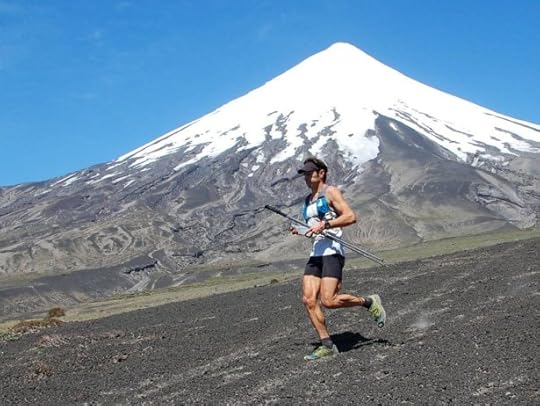Reader Q || Poles for ultra trail running: recommendations, sizing, & carrying


Pushing hard on my poles at UTMB, climbing out of Arnouvaz towards Grand Col Ferret shortly after sunrise at Mile 61.
From reader Matt. P of Knoxville:
I’ve been hiking for years with conventional telescoping poles and love them. But in May I’m running/hiking the Cruel Jewel 100, which has 33,000 vertical feet of gain, and I’m looking for a trekking pole that is better suited to an ultra trail marathon. What poles do you recommend, and do you have any tips on how to size and carry them?
The value of poles in an ultra depends on:
Individual fitness,
Course length, and
Amount of vertical climbing.
Essentially, the more hiking you expect to do, the more valuable they will be. Participants in the middle and back of the pack will hike more than the front-runners, but some courses like Hardrock — a 100-miler with over 30,000 vertical feet of climbing at elevations up to 13,000 feet above sea level — bring even the world’s fittest ultra runners to a crawl. Whether to bring poles is a personal decision for every competitor: Is the benefit worth some added weight and fuss?
I’ve used poles only in two races: Vulcano Ultra Trail, a 100k with 13,000 vertical feet of gain and 30 miles of beach sand-like volcanic ash; and Ultra Trail du Mont Blanc, the famous 100-miler in Europe that last year had 32,000 vertical feet of gain. Other runners in these races made their own calculation.
Benefits of poles for ultra runners
Backpackers have considered poles to be essential equipment for many years, and ultra “runners” are slowly coming around. When I ran the Leadville 100 in 2008, I was one of the few who used them. But when I last spectated the race in 2013, they seemed much more common. The realization is, “If Kilian, Francois, and Walmsley all use poles in hard races, maybe I should, too.”
Poles enable the arms to help the legs with forward and upward propulsion, and with braking on descents. Net energy burn may actually be greater with poles, but the workload endured by the legs is reduced, helping to preserve strength for later in the race. Poles also provide stability on slick surfaces like mud or wet rocks, and additional points of contact when fording or rock-hopping across streams.
Recommended poles for ultra runners
Traditional telescoping poles like the Black Diamond Alpine Carbon Cork (long-term review) or Cascade Mountain Tech Quick Lock Poles (long-term review) do not work well for ultra running. They are:
Too unwieldy even at their minimum length;
Slow to extend or collapse; and,
Unnecessarily sturdy (and heavy).
Much more appropriate for ultra running are foldable poles like the:
Black Diamond Carbon Z ($160, 10 oz), which I own;
CAMP Xenon 4 ($110, 10 oz); and,
RaidLight Compact Folding Carbon ($150, 12 oz).
These models pack down much smaller, and are therefore less clumsy to carry. For example, my 47.2-in (120-cm) poles collapse to just 15.4 in (40 cm). In comparison, my go-to backpacking poles collapse to just 25 in (63 cm), or almost 10 inches longer.

Foldable poles are dramatically shorter than traditional telescoping poles, making them much less unwieldy while being carried.
Most foldable models are fixed-length, i.e. non-adjustable. Some offer a micro-adjustment of 6 inches (15 cm) but I don’t find this to be a valuable feature for ultra running. It also adds weight and expense — about $20 and 3 oz per pair, in the case of the Black Diamond Distance Carbon Z versus the Distance Carbon FLZ.
To keep these poles lightweight, these poles have thin shafts that are not as strong or sturdy as most telescoping poles. But for running/hiking on trails without a heavy pack, I think they are sufficient, and I don’t see reason to buy poles with beefier shafts like the Black Diamond Alpine Carbon Z.

The length of traditional telescoping poles is finely adjustable, whereas most foldable poles are fixed-length. To collapse them, press the push-button at the lower end of the grip. To lock them, extend the poles until the bush-button snaps into place.
Sizing
When holding my pole vertically, I like my elbow to be at a 90-degree angle. If I’m between sizes, I size up, so that my elbow is slightly less than 90 degrees. A longer pole allows for a more sustained push, as demonstrated by Nordic skiers.
Baskets & straps
If possible, I remove the included “mud baskets” — they serve little purpose, and they slow down the swing speed.
Straps are more optional. With them, greater pressure can be applied to the pole, and they need not be held so tightly. However, they tether the poles to my hands, which I also need for eating, drinking, and — God forbid — catching myself if I were to fall. For races with long, sustained climbs, they make more sense to me than on rolling courses with short but constant climbs that will necessitate frequent transitions.
Carrying
Do not wait until race day to determine how best to carry poles when not in use. Bring them on training runs beforehand so that you can practice transitions and experiment with various carrying options. If you do not heed this advice, you will probably find the the poles to be clumsy and you will probably lose time to futzing with them.
There are several options for carrying stowed poles, listed below. Your equipment may have a default method — if you don’t like it, buy something different or modify its attachment system.
In your hands;
Attached vertically to shoulder straps, a la Ultimate Direction Mountain Vest 4.0;
In a rear mesh pocket;
Secured horizontally at the waist, a la Naked Running Band;
Diagonally across the back, a la Salomon Advanced Skin 12; and,
A dedicated holster, like the Salomon Custom Quiver.
There is no perfect technique — each has downsides, some more than others. Ultimately, your method should:
Allow for a quick and clean transition;
Secure the poles well, with no bouncing and no risk of them falling out; and,
Keep your hands free and your poles out of the way.

Prior to Vulcano Ultra Trail I had not trained with my poles and did not have a good way to carry them, besides in my hands. I thought the poles were worth it, but I regretted my lack of preparation.
Questions about buying or using poles for an ultra? Have an experience that you’d like to share? Leave a comment.
Disclosure. This website is supported mostly through affiliate marketing, whereby for referral traffic I receive a small commission from select vendors, at no cost to the reader. This post contains affiliate links. Thanks for your support.
The post Reader Q || Poles for ultra trail running: recommendations, sizing, & carrying appeared first on Andrew Skurka.



